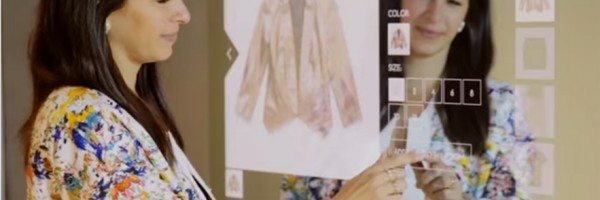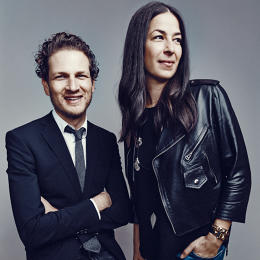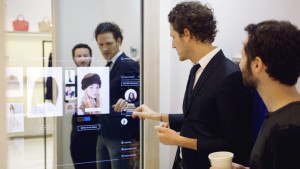MIRROR, MIRROR ON THE WALL: REBECCA MINKOFF’S STORE OF THE FUTURE

Rebecca Minkoff's fashion-driven, tech-focused store caters to shoppers' every need.
Have you ever stood in a dimly-lit, cramped room half naked and feeling lost and confused? No, it’s not the Matrix. It’s just your typical fitting room scenario. Too often I have been too embarrassed to ask for help from a store associate or overwhelmed by the number of choices a store has to offer. And let’s face it, sometimes what you see isn’t what you get. That outfit may look great in the store’s nightclub lighting, but in the light of day, everything looks different. Uri and Rebecca Minkoff, CEO and founder, respectively, of Rebecca Minkoff, understand the shopper’s dilemma and actually did something about it.

Launched in 2001, Rebecca Minkoff’s playful and edgy designs captured the attention of the fashion industry. From a single t-shirt and later, a single handbag, born today’s extensive apparel and accessories line. Today, the brand can be seen on celebrities and fashionistas alike. At a growth rate of 20% annually and nine figures in sales volume, Rebecca Minkoff has been successful as an entry point into the luxury market.
Rebecca Minkoff recently partnered with eBay to deliver a store of the future in the Big Apple. The brand’s Manhattan store features a mirrored wall at the entrance where shoppers can order a drink and browse through lookbooks. Adding clothes to the dressing room is as easy as touching a few buttons, eliminating the need to carry piles of clothes while you browse.
Still want that arm workout? You can also opt to shop the traditional way, but what happens in the dressing room is another experience all together. Each dressing room features a high-tech mirror. Articles of clothing or accessories are tagged by RFID and appear automatically on the mirror as you walk in. From there, shoppers can order different sizes and mix n’ match outfits by simply tapping on the mirror. Within minutes, a sales associate will appear with all your heart desires.

No more putting on an outfit just to step out and ask for help. The help comes to you. And because the sales associate knows your size and dressing room pieces, she can bring you items that go well with what you already have. The dressing room is also outfitted with different lighting “so you can see what it might look like in your end use case,” says Uri Minkoff.
The seamless shopping experience ends with the shopper checking out within the dressing room via PayPal or traditional methods. Shoppers can also receive an email with everything they tried on that day and purchase the products online at a later time. The fast and the not-so-furious experience is the girl-on-the-go’s dream.
Creating a shopper-friendly atmosphere can certainly boost sales, but Rebecca Minkoff also benefits from the vast amount of data it now has on its customers and their shopping habits, which can influence future designs.
With data comes great power, but nothing can trump the importance of creativity and gut feeling in fashion. If brands can create the perfect balance, the marriage of tech and fashion can indeed create something beautiful.
The question remains, what will you be asking of your mirror in the store of tomorrow?
Check out a video of the Rebecca Minkoff store experience here.



This is insanely cool and something that can dramatically transform the entire retail industry. The data gathered on individuals and the payment integration is a true sign of digital innovation. I am genuinely surprised and impressed by this brand as I still remember the days I would go to their Los Angeles sample sales with Uri manning the cashier. I hope that the large capex invested in the prime retail storefront and technology pays off. Perhaps the initial buzz and PR is just want is needed for this to go mainstream in the large high-end department stores of today.
I agree this is super interesting! The technology in the store is quite impressive and can obviously boost sales through bigger basket sizes via the cross-selling and upsetting that occurs in the dressing room. Like you, though, I must admit that I’m more excited about the value that the data collected can unlock. Rebecca knows what pieces are being brought into the dressing room but not purchased, what pieces are usually tried on together, what styles are ultimately bought by different consumer types, etc. The value of this information transcends well beyond getting you to buy one more piece of clothing while you’re in the store. For instance, Rebecca and team can use this data to improve sell-though in the wholesale channel as well as inform next year’s collection, just to name a few. A lot of brands have tried to bring the offline experience online in response to the digital revolution but Rebecca is taking the opposite point of view. It will certainly be interesting to see if other brands decide to invest in a similar approach.
Great post! In fact, I was going to write my post on the topic of how digital is now transforming the in-store experience along with enabling e-commerce. Rebecca Minkoff is at the forefront of creating an easier, more personal in-store experience using custom, built-in technology, thereby eliminating the awkwardness of making a personal styling appointment and then feeling pressure to buy products at the end. This is the first step towards bringing the personalization that companies can offer on their e-commerce sites from the minute customers log on to brick-and-mortar locations. Typically, a store can only pull up your customer profile when you present your loyalty card at check-out – if you make it to the register. Rebecca Minkoff could use the in-store technology to recognize customers as they walk in the door and populate the dressing room mirror/ in store displays with recommendations based on their previous purchases, likely increasing conversion to purchase.
I agree with the above comments. There are several things about this I really like. First, they offer great and seamless service (which is feasible with the huge margins they achieve). Second it addresses many pain points of the retail experience such as waiting half naked in the dressing room, feeling rude not purchasing anything after trying on a lot of items, and poor lighting and space. Third it syncs with the online experience (another option they could consider would be the option to have the clothes shipped to you free if you didn’t want to carry them around but wanted to buy them at the store. I recently did this at a ModCloth pop up in San Francisco and it was great). Finally the data on customer’s preferences and the ability to leverage this data in a followup email is huge. I’m curious what their “abandon cart” rate is and how well they do with followup. Really excited about this innovate concept!
An incredibly interesting and well-written post, capturing the readers attention.
I agree, in retail the dressing room as a concept is one that is currently flawed and has not evolved for many years – it is due some disruption! Rebecca Minkoff has created an engaging and new customer experience to streamline the current dressing room experience, but I wonder if this is enough. For me, the real innovation will be bridging the gap between online and offline. Using data to help customize orders and subsequent ‘testing’ of the products in a completely new and innovative way, beyond just enhanced lighting, touch screen mirrors and heightened shop assistants who use data to cross sell. For me, the real innovation will be in changing the whole idea of ‘testing’ clothes. From being able to test clothes without actually wearing them through virtual reality and the use of 3D scanners, or from testing the clothes through a much longer experience ie/ for a day, so you can see how easy it is to walk, and if there are any ‘bugs’ as you wear the clothes in the context of your normal day.
Excellent post, JP. I can’t wait to visit this store! Like Kathryn, I am also excited about the value of the data that will be collected by the new dressing-room experience. I have often wondered if home closets will become digitized through RFID tags allowing the retail shopping experience to become more personalized — curated to the taste of the individual shopper based on their existing wardrobe. For example, I can match a new top to an existing pair of pants that I already own by being able to access my closet through my mobile phone. As a result, I think that bigger basket sizes could result from the cross-selling of new clothing pieces and accessories based on those that you already own to create truly stylized outfits. There are so many ways to expand on this premise to create more value for the customer — what about linking stores’ e-commerce sites to their retail stores and allow customers to try-on clothes that they have picked out online at a specific date/time? I’d be interested to know how these new digitized shopping experiences affect number of employees per shop and inventory levels. I would assume that stores would need to hire more employees to populate the dressing room and more inventory would be necessary as the technology allows a greater flow of clothes in and out of the dressing rooms.